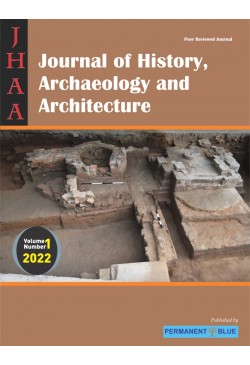
Journal of History, Archaeology and Architecture
Frequency :Bi-Annual
ISSN :2583-5106
Peer Reviewed Journal
The Indian Collection of Early 20th Century Prints With Slovene Ethnographic Museum Ljubljana: Between Colonialism and Indian Nationalist Discourse
Gupta, K. 2023. The Indian Collection of Early 20th Century Prints with Slovene Ethnographic Museum Ljubljana: Between Colonialism and Indian Nationalist Discourse. Journal of History, Archaeology and Architecture, 2: 1, pp. 1-26.
Some Recently Discovered Yaudhey Coins Throwing Fresh Light on Their History and Polity
Discovery and Decipherment New Sāti Inscriptions From Erān, District Sagar, Madhya Pradesh
Chadhar, M.L. 2023. Discovery and Decipherment New Sāti Inscriptions From Erān, District Sagar, Madhya Pradesh. Journal of History, Archaeology and Architecture, 2: 1, pp. 33-41.
History at Museum
Ramana, R.V. 2023. History at Museum. Journal of History, Archaeology and Architecture, 2: 1, pp. 43-46.
Caste Wise Gastronomy Practices and Ingestion Manners of Andhradesa Observed By Travelogues
Rao, J.C. 2023. Caste Wise gastronomy Practices and Ingestion Manners of Andhradesa Observed by Travelogues. Journal of History, Archaeology and Architecture, 2: 1, pp. 47-54.
The Role of Domestic Goat in Harappan Economy
Kumar, S. 2023. The Role of Domestic Goat in Harappan Economy. Journal of History, Archaeology and Architecture, 2: 1, pp. 55-70.
Rock Art of the Koria District with Special Reference to Murelgarh Hill
Gond, H.S. 2023. Rock Art of the Koria District with Special Reference to Murelgarh Hill. Journal of History, Archaeology and Architecture, 2: 1, pp. 71-75.
A General Study of Indus Valley Civilization Trending Relations with Comparative Asian Countries
Yadav, D.P. & Bhatt, R.C. 2023. A General Study of Indus Valley Civilization Trending Relations with Comparative Asian Countries. Journal of History, Archaeology and Architecture, 2: 1, pp. 77-84.
An Unprotected Archaeological Site: Bawdi Mukund Pura (Stepwell)
Nitin 2023. An Unprotected Archaeological Site: Bawdi Mukund Pura (Stepwell). Journal of History, Archaeology and Architecture, 2: 1, pp. 85-93.
Radhanagar : An Early Historic Buddhist Settlement in South Eastern India
Patnaik, S.K. & Nayak, S. 2023. Radhanagar: An Early Historic Buddhist Settlement in South Eastern India. Journal of History, Archaeology and Architecture, 2: 1, pp. 95-119.